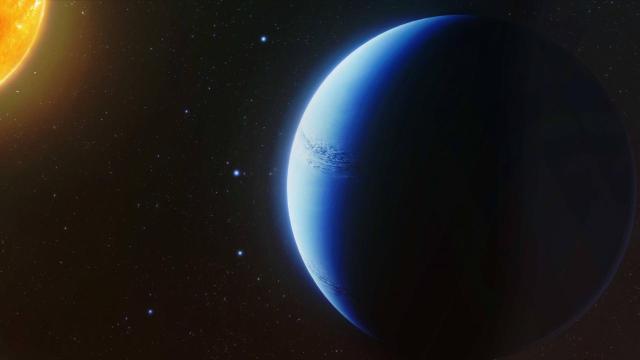Astronomers have detected an exoplanet whose sodium-rich atmosphere is completely devoid of clouds – a strange celestial feature that until this point only existed in theory.
The planet is called WASP-96b, and it’s located about 980 light years from Earth. This distant world is what astronomers call a hot-Saturn – a planet with a mass comparable to our own Saturn (even though this one is 20 per cent larger than Jupiter), but with considerably hotter surface temperatures (in this case, temperatures can exceed 1000C). A year on WASP-96b only lasts about three days, which should give you a sense of how close it is to its host star.
The temperatures on this blazingly hot world may be unbearable, but visitors to this exoplanet wouldn’t have to worry about any clouds or haze obstructing their view of the heavens. As new research published in Nature shows, WASP-96b’s atmosphere has no clouds. Not a single one – not a fluffy cumulus, a hazy stratus, or wafting cirrus. Not even haze exists on this world.
The reason has to do with the atmosphere’s primary ingredient: Gaseous sodium. The ubiquitous presence of this element makes it impossible for haze or clouds to form and remain stable.
Prior to this discovery, astronomers had predicted that some gas giants with an overabundance of atmospheric sodium would be cloud-free. These latest observations are now the first to prove it. Sodium is the seventh most common element in the universe, and it’s previously been detected around Mercury, within cometary tails, and in the atmospheres of some exoplanets. But WASP-96b’s “absolute sodium abundance” precludes the possibility of clouds.
Astronomers have known about Wasp-96b since 2013, but a recent survey of this planet and the atmospheres of 20 similar worlds led to the cloud-free discovery. The scientists couldn’t actually see the cloud-free skies of the planet. Instead, using the Very Large Telescope in Chile, a research team led by Nikolay Nikolov from the University of Exeter captured the planet’s spectral signature as it passed in front of its host star.
The incoming wavelength pointed to sodium, and with a spectrum that was in “excellent agreement” with a pristine, cloud-free environment.
“WASP-96b is the only exoplanet that appears to be entirely cloud-free and shows such a clear sodium signature, making the planet a benchmark for characterization,” said Nikolov in a statement.
“Until now, sodium was revealed either as a very narrow peak [as seen in the spectral graph] or found to be completely missing. This is because the characteristic ‘tent-shaped’ profile can only be produced deep in the atmosphere of the planet, and for most [planets] clouds appear to get in the way.”
It’s an important discovery, because clouds have a profound effect on a planet’s climate, blocking out light, absorbing aerosols, and sometimes producing rain that falls on the surface. The trouble is, knowing which planets are capable of producing thick clouds isn’t easy, given the vast distances involved. WASP-96b will now provide a good model for researchers as they move forward.
For the next stage of this research, the scientists are hoping to determine how much water, carbon monoxide and carbon dioxide exists on WASP-96b, offering a fuller picture of this world and its unique atmosphere.
[Nature]
